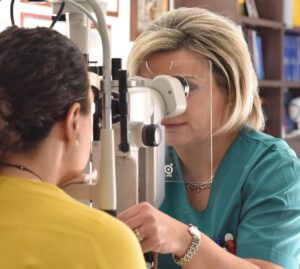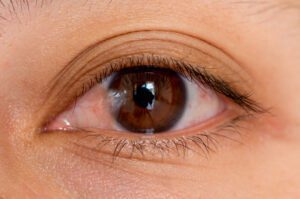

Glaucoma is a chronic disease that leads to vision loss. Glaucoma can be blinding.
It is the 2nd cause of blindness in the world (after cataract).
In the early stages of the disease there may be no symptoms. Half of people with glaucoma do not know they have the disease.
The incidence of glaucoma in the general population is 1-2%. So in our country we have at least 100,000 people who either have glaucoma or are candidates to develop glaucoma (suspected cases of glaucoma).
What is intraocular pressure?

The pressure that the eye has.
It has nothing to do with blood pressure directly. It is measured with special instruments, the tonometers, and usually does not exceed 20-21 mm Hg. However, one may have glaucoma while having “low” blood pressure, or may not have glaucoma while having relatively “high” intraocular pressure. In addition to intraocular pressure, there are other etiological factors for glaucoma.
Types of glaucoma
The most common form of glaucoma is open-angle glaucoma. Open-angle glaucoma occurs when the infiltrating filter does not work well, through which the inner fluid of the eye, the clear aqueous humor, drains into the bloodstream.
The increased aqueous humor puts pressure on the inner walls of the bulb and the optic nerve, which is made up of sensitive and thin nerve fibers of about 1,200,000 nerve fibers, like “power cord wires.” The constant pressure and crushing of these nerve fibers leads to their progressive and irreversible destruction. The optic nerve is responsible for transmitting the image from the eye to the brain. Its damage causes loss of field of vision, loss of vision and in the final stages blindness.
In the case of narrow or closed angle glaucoma, which is relatively rare, the infiltrative filter is “blocked” by the iris due to the narrow angle of the anterior chamber, an angle formed between the cornea & the iris. In hyperopic eyes the angle is several times “narrow”, especially when there is a waterfall in progress.
Narrow or closed angle glaucoma can cause acute and high blood pressure, it is always treated as an emergency with possible hospitalization. If not treated in time within the first twenty-four hours it can lead to permanent vision loss.
Another form of glaucoma is normal pressure glaucoma, an “insidious” glaucoma, where the intraocular pressure remains at normal “normal” levels, but the condition worsens with progressive loss of vision.
The symptoms of glaucoma
It usually has no particular subjective symptoms. Slight blurred vision, halo around the lights, deep pain in the eye, etc. are not always evaluated by the patient.
In the final stages of glaucoma there is difficulty in night vision and reduced visual acuity. The disease progresses slowly to the stage of absolute glaucoma in which vision is lost.
In acute glaucoma there is severe pain, decreased vision and a tendency to vomit.
The diagnosis of the disease is made from what the Ophthalmologist sees


with special examinations
- Measurement of Intraocular Pressure
- Dredging
- Angleoscopy
- O.C.T. (Optical Nerve Cohesion Tomography)
- Corneal Thickness &
- Visual fields
But who is at risk for glaucoma?
Everyone is in danger…. A complete ophthalmological examination is required every two years after the age of 40 and every 2-4 years before the age of 40.
There are some groups of people who are at higher risk than others, such as:
1. People over 60 years
2. Family members with a hereditary history of glaucoma
3. History of eye trauma
4. Use of steroids (cortisone)
5. Race African-Americans & Asians
Other potential risk factors include:
hin corneas (central thickness less than 500 μm)
High myopia – Diabetes mellitus – Hypertension
Everyone is at risk for glaucoma
Older people are more likely to develop glaucoma. However, it is possible that glaucoma may occur in very young people, adolescents, children and even infants (1 / 10,000 infants have glaucoma).
There is currently no definitive cure for glaucoma.
However, medication, lasers or surgery can slow down or prevent vision loss. Appropriate treatment depends, among other factors, on the type of glaucoma.
However, 10% of people with glaucoma, who receive appropriate treatment, lead to loss of vision….

- Early detection is therefore vital to prevent disease progression.
- Glaucoma, as a serious chronic disease, must be monitored for life.
Do not neglect your eye examination…
Prevention is always the best treatment.







